It was August 2075 in Brussels.
A dying arts and antiquities dealer needed an heir – a suitable one, one that wouldn’t squander and ruin the business he had spent his life making. He had a son, Dieter. But Dieter was an aimless, unintelligent boy who showed no interest in anything and could barely maintain a conversation. He’d never be a suitable heir to his father’s business.
Not with the brain he’d been born with.
Artificial brain-links had been common for a decade.
But the real deal – sophisticated motivational backbrains with symbiotic neural attachments – were illegal.
“Illegal” simply means “expensive,” for people who have connections.
So the arts dealer made the arrangements.
In the city of Brussels in 2075, there were thousands of boys who were not very bright or likable; who had troubled and resentment-laden relationships with cold and distant fathers; who had minds and temperaments, due to biology and circumstance, that did not add up to an agreeable or impressive social concoction.
And there were thousands of wealthy fathers who were disappointed and ashamed of their sons.
But only one of those boys was sent to an unlicensed research lab in France to have an experimental surgery performed, one that was followed by months of recovery in an out-of-the-way rehabilitation center near the North Sea. And only one of those fathers had the mania for a suitable heir and the survival of his good name – and also the peculiarly high level of distaste for his offspring – to arrange for such a surgery to be done.
The boy’s name was Dieter.
The surgery was the insertion of a backbrain.
The effect of the backbrain wasn’t immediate. It had to work its way into and around the neural pathways of the boy’s real brain; pour like water into its gray tissues and embed itself in the fissures and cracks it found there. It would not be an instant cure for the poor mental abilities of its host. Dieter would still have to go to school and struggle to learn so that the connection to the backbrain would be forged. The frontbrain would have to forge channels to the backbrain so it could access the information and impressions that would be indelibly stored there. The backbrain could not think for the frontbrain. But it could make thinking easier and produce substantially better results.
It could inject motivations and curiosities. It could stimulate the pleasure centers of the brain when intellectual goals were achieved. It could operate like a “wise drug” and lead the frontbrain toward passionate motivations. It could override the frontbrain’s laziness and lead it on dogged pursuits of information and ideas. And it didn’t forget anything it learned.
Dieter was a listless and easily-manipulated boy. He wanted to be led around, he wanted to be told what to do. He didn’t want to think for himself, he didn’t want to think at all. The backbrain took advantage of that. It moved in. It took charge.
It was still a year till Dieter began middle school. Dieter’s father was rarely home. He traveled the world on business. He lectured and negotiated the sale of Dutch and Flemish paintings around the globe. Dieter was watched over by house servants and attendants. They had never liked the boy and they were happy to let him spend most of his time in his room, which he did, tuning into the silent agendas of the backbrain.
Dieter started middle school with good grades. His father was pleased. Until that year, it was only a series of generous donations to Dieter’s school that kept the boy passing from grade to grade. He had become more social and outgoing as well – at least with the teachers and other students at school. At home, he kept to himself as much as ever. He was indifferent toward the staff and housekeepers, and distinctly unaffectionate toward his father.
The boy was studious, and with each passing school year he got better grades. The schoolwork began to seem easy to Dieter. He made up for this by studying more advanced subjects at home. He took on extra projects at school, if he felt genuinely interested. His father was pleased to see that the boy gravitated toward studies of art and history, subjects which would be essential if he were ever to inherit the family business. This, however, was mere serendipity. The son was not trying to please the father. His interest was genuine. It had been coaxed out by the ministrations of the backbrain, but it had been present in Dieter, lying dormant all the while.
The boy was aware of a rift in himself. His thoughts were engaging and his head was full of them. But he felt as if he were observing his thoughts rather than thinking them. That his pleasures and his excitements came wrapped in a translucent covering that he was not able to remove.
In the later years of middle school, the backbrain got Dieter to go to the gym.
Dieter spent two hours every evening working out behind the steamed-up windows of a weight room in Brussels. While Dieter pumped and sweated, the backbrain processed information and worked concepts of aesthetics and philosophy into the front.
Dieter was not a bad-looking young man. But he was flabby and pale and physically weak. A year in the weight room changed all that. His muscles became strong and sharply defined. His movements got quicker and more focused. Girls started to look at him. Boys, too.
There was no backbrain independent of Dieter. But Dieter was becoming more than he’d have ever been, or ever could be, without it.
One autumn morning, during his first semester at university, Dieter woke up before the alarm went off. He felt odd and agitated. He got up and washed, attending to each stage of his grooming with quick, focused movements. Shower, soap, shampoo, brush, comb. His clothing mattered, suddenly. He chose things that were clean, he took yesterday’s clothes off the floor and put them in the hamper. His coffee smelled different – no, stronger. And the toast and jam on the plate – delicious. He decided to skip school; he wanted to go to Bruges.
The train was full of vivid, explosive, exotic, and wonderful sounds. It was as if he hadn’t heard sounds like them in his life. Had the train always sounded like this?
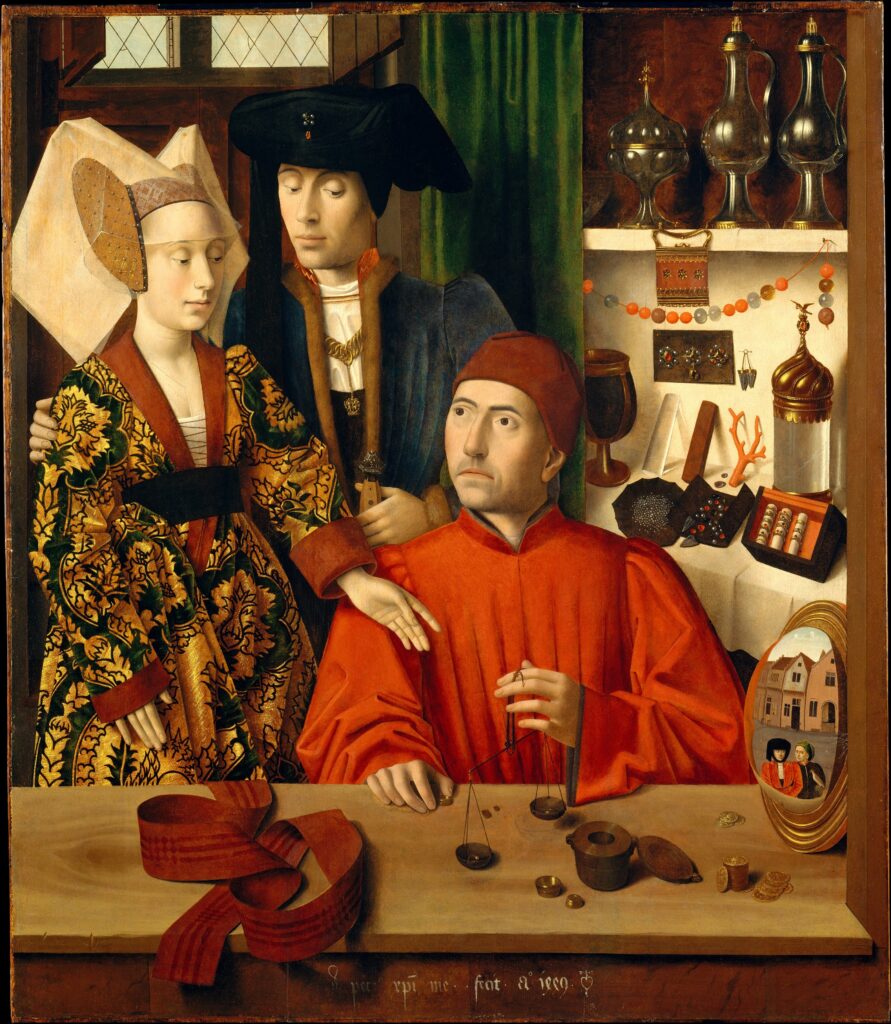
In Bruges, he leaned over the canal, and watched fleets of swans glide on the water below him. He thought: I am not seeing swans, I am seeing light reflecting on swans. What does a swan look like without light to describe it? He thought of the Petrus Christus painting they’d studied last week, A Goldsmith In His Shop – that little reflection of light on the rim of a weight for the scale. Just a dot of paint. And yet, at the same time, it was light itself, it was the revelation of how light worked. Swans glided under the bridge, swan after swan, the light brilliant on their backs. The light shone on Dieter’s back, watching them from above.
What did Dieter look like, he wondered, without light to describe him?
Things were different. Dieter had changed. His thoughts no longer came in translucent wrappings. The backbrain and the frontbrain had merged. From then on, it would not be merely Dieter’s behavior that changed. It would be the man himself.
At university, Dieter would have been at the top of his classes – if he weren’t so fond of skipping school and running off to Bruges.
Meanwhile, the awakening of Dieter’s listless mind was a great relief for his father, who had paid so much money for its wake-up call.
There was one thing, however, that the father could not miss: the boy’s disdain for him. It was something quite beyond a mere adolescent resentment of authority. Dieter could be charming when he wanted to be. His instructors at the university all spoke glowingly of him. But in the presence of his father, he was either surly and unresponsive or hostile and sarcastic.
Dieter’s father could live with that. He was traveling most of the time and didn’t have to spend much time with him. He didn’t feel the need to love the boy, or even like him,as long as he could be proud of him.
Bruges, 2085.
Dieter was approaching the entrance of the Groeningemuseum in Bruges. He slipped off his smog filter a little too soon, just shy of the entrance, and he coughed as he paid the admission. The museum attendant nodded and confirmed that the air was at “red level” today.
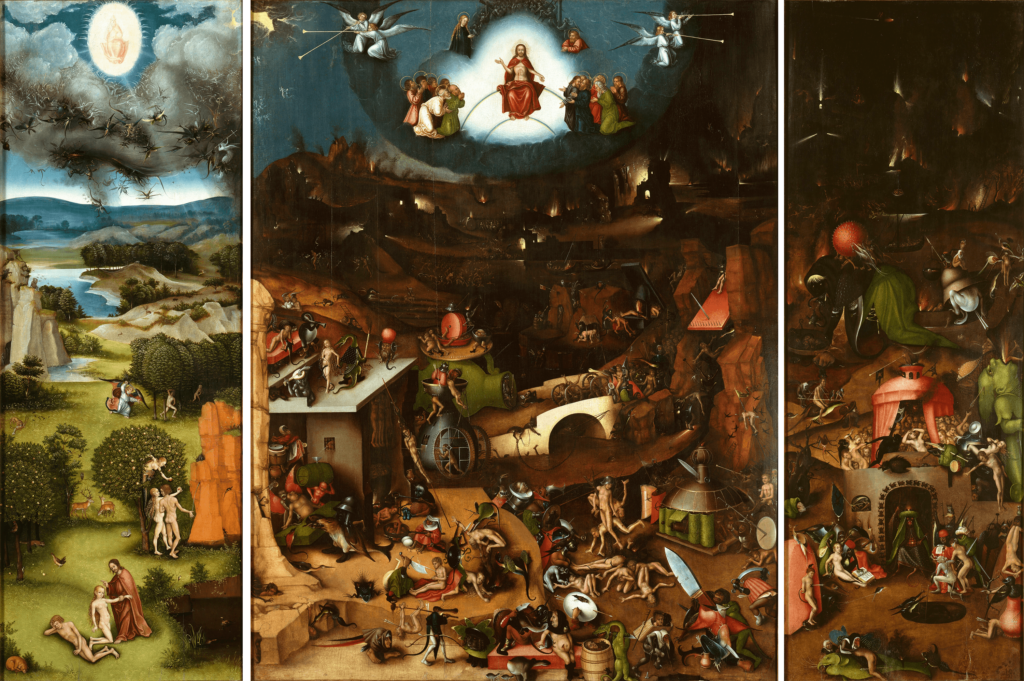
Dieter went to the Bosch tryptich first, as he always did. The Last Judgment. judgment day paintings fascinated Dieter, they roared in his mind. His heartbeat quickened. His eyes felt boiled by the turmoil and terrifying majesty of them. After the Bosch tryptich, he visited Jan Provoost’s Last Judgment.
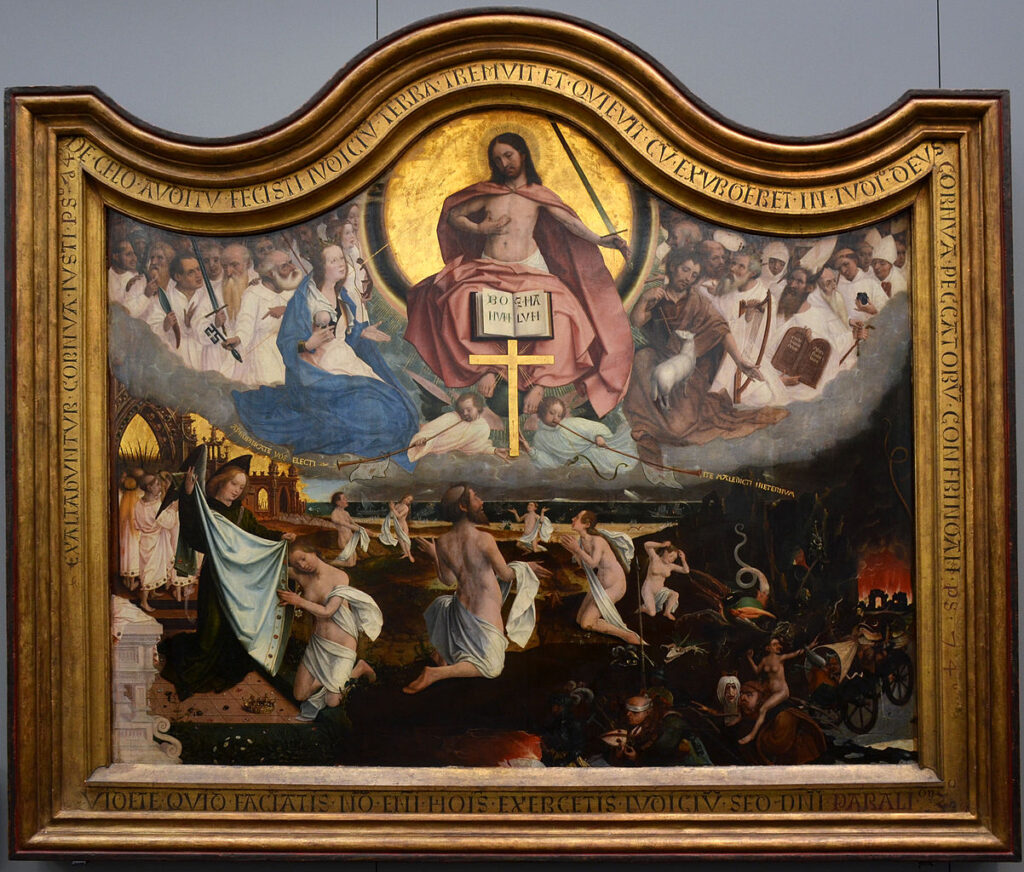
Dieter had rejected the Church and the idea of a judging God long ago. Still, there was something in these paintings that moved him, and stood in his heart as unshakably and fiercely real.
Dieter had no intention of becoming an art dealer. But he had developed a deep and insatiable appetite for art. He was fortunate: the body of art that most moved him, early Flemish and Belgian religious art, was everywhere around him. A day of walking through crowded Brussels, a hop on a train to nearby, wonderful Bruges, and he could gorge himself on any number of medieval masterpieces.
He was also moved by the more recent Belgian painters; the Symbolists, the Surrealists.
He loved Magritte. Magritte, who was everywhere. Not just in the museums, but everywhere in the world around him. New technologies were seeping into the world and changing it in magical ways. Belgian gift shops sold bright green holographic apples one could wear on their face; the wearer could see through it, but to anyone else it was as flat and opaque as the apple in Magritte’s The Son of Man. One year, on Magritte’s birthday, hundreds of three-dimensional bowler hats were projected onto the crisp blue Belgian sky for twenty-four hours.
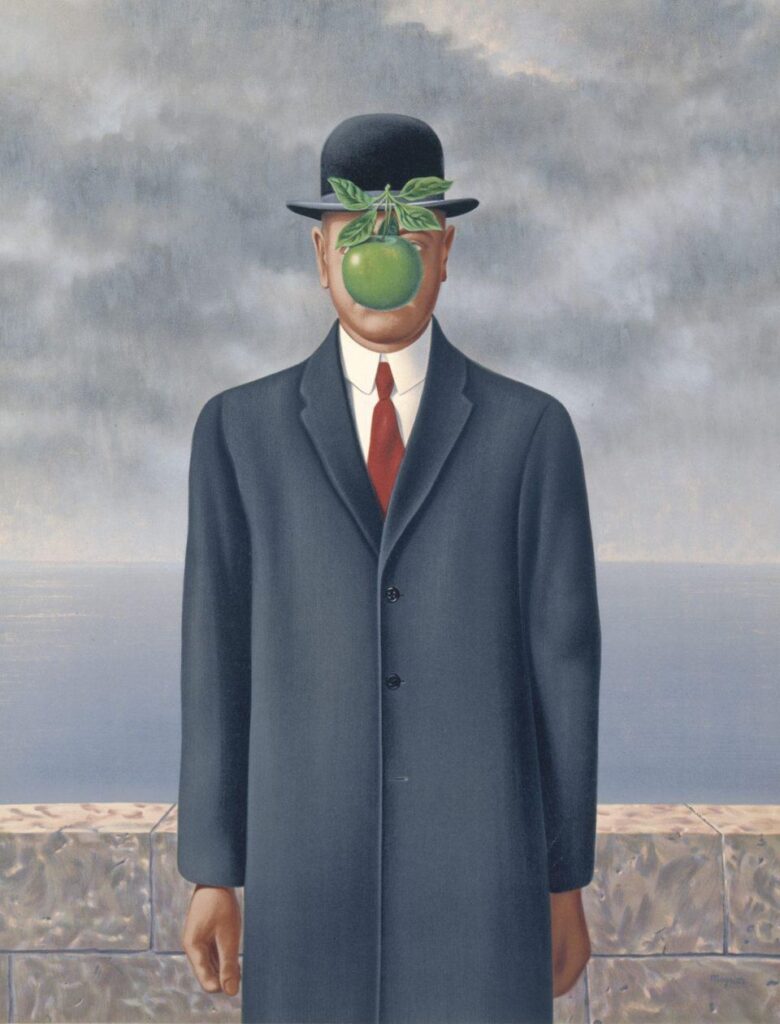
The world itself had entered a new era of pipes not being pipes. Technology was permeating society in strange and diverse ways and most things were actually facades for something else. Every person and thing in the world had sprouted new and hidden identities.
Dieter was engaged in an intense study of the Bible. It was essential for the prospective expert on religious iconography. He studied under the finest tutors in the world, in addition to his university courses. His zeal was not religiously motivated, nor was his passion strictly academic. His zeal was born of his love for art itself, and how it used the language of religion to express something truer than religion could ever hope to utter.
Dieter had never felt moved by the claims of any organized religion, its promises, or its threats.
He allowed the possible existence of something one might call “God.” But if Dieter’s path and God’s path were to cross, he was certain it would not be through the intercession of the charlatans and profiteers of the Church. Dieter felt the presence of the Holy, but in art alone. In art he saw – not the presence of a God who might not exist – but the presence of a human soul which certainly did.
The language and images of the Old and New Testaments had been used, brilliantly, to express that human soul for centuries. Dieter walked miles of museum hallways, studying that brilliance. And when that language and those images fell short, there were those later works, those later paintings, the Hermetic language the Surrealists had spoken, that found holy places in the naked hearts and dreams of men.
The motives of his fellow students were mercenary. There was money to be made these days in art-related fields. The art market was booming. Works of art were being moved and relocated all around the world in response to political and environmental dangers. Each day brought the threat of a new war. The shuffling of art between nations could keep an art dealer or curator busy – and rich – for life.
Pollution and bad, corrosive air were literally eating paintings the world over. So the field of art preservation was also becoming extremely lucrative.
Dieter attended school with young men and women who aspired to be like his father. They were looking for the money in art, not the holy.
They envied him for his famous father and the equally famous arts and antiquities dealership Dieter was sure to inherit.
It was at one of their rare dinners together that Dieter told his father he wanted nothing to do with his business. He would not work for him; he would not take over for him, when his father became too old to run it.
For some time, Dieter’s father had been arranging for Dieter to do exactly that. He’d arranged for Dieter to attend exclusive parties and lavish events. He’d hired advisors to guide Dieter through these affairs, and to teach him the complex web of connections and social maneuvering required to thrive in the world of high-end art brokering. He’d been pleased to hear that Dieter had developed shrewdness and social grace, and an absolute flair for opportunistic conversation. And, of course, Dieter’s knowledge and prodigious memory amazed everyone, for no one but Dieter’s father knew about the backbrain.
He had arrived at the restaurant that night prepared to discuss the plans he had for Dieter’s future.
Without hesitation, Dieter threw all those plans back in his face.
The older man wasn’t completely taken by surprise. He knew his son loathed him. He was sure this was just a temporary rebellion.
Retaliation was called for. He didn’t cut Dieter off completely. After they’d argued, he told Dieter that his education would be paid for until its completion. But nothing else would be provided. His generous allowance would be cut off the moment they left the table. And if he hadn’t changed his mind by the last day of his schooling, he would be completely disinherited.
Dieter left the meeting with his father feeling that he had been the victor. But as weeks passed, he felt the sting of his father’s reaction. He was used to having whatever he wanted, if it was something that money could buy. He wished that he had waited till he was out of university to tell his father off.
His education, the thing that mattered most to him, was still being paid for. It was the near-termination of his personal allowance that truly stung him.
Dieter did not like really his classmates. But he was lonely, and frankly, starved for human contact and intimacy. Dieter’s classmates were young and intelligent and worldly and sexually attractive. And above all, they were rich. If you were to be accepted by them, if you were to spend an evening clubbing with them, you had better be rich, too. You had to have parents who would pay for your wild nights out at the club, for your globe-hopping holidays, for your drinks and drugs and fast cars.
Dieter was barred from that world now.
He was too proud to beg his father to reconsider.
Months passed, and Dieter grew more alone, and more unhappy. One day, another way of getting money occurred to him.
Crime.
The train stations of Brussels were haunted by droves of illegal brainware dealers. They called themselves ’ “warewolves. ” Brussels was full of schools and universities. The demands on students were high and competition was fierce. It was hard for a student to survive in the academic environment without something extra.
Selling brainware was an illegal and risky business. But a good ’warewolf could make a lot of money doing it.
Dieter became a very good ’warewolf.
The ‘warewolves weren’t selling anything remotely as advanced as the hardware Dieter carried in his own skull. In fact, no one was selling anything like that anymore. Backbrain insertions had caused slow but severe damage to the central nervous system of 97percent of the subjects they had been tested on. Some were dead. Others were in wheelchairs.
Only one of those early test cases was thriving and active. And selling illegal brainware in Brussels.
In the ten years since Dieter had his surgery, the developers of the backbrain technology had been run down and jailed by ever-more-sophisticated units of Enhancement Police. Other, less invasive, applications were being sold on the sly now. No one talked about backbrains anymore.
Dieter knew that some work had been done on him when he was a boy. He dimly remembered his long recovery at the North Sea. But he never guessed that something as complex or untested as a backbrain had been installed in his head.
The brainwares the ’warewolves sold at the train station were simple: temporary brain boosters and memory chips; intelli-stims that were absorbed by the scalp and washed away in a few hours; datathreads one injected near their temples. Nothing too fancy, nothing long-lasting, but just what a student needed to get through four years of classes and exams.
The years that followed were intense and exciting. Dieter would jump out of bed and hurry to the train station. The ’warewolves would be prowling, seeking out nervous-looking new students and stalking the older ones, who’d become regular customers. Getting caught meant certain jail time for a ’warewolf. But the risk just made it more thrilling. Cops were always looking for ’warewolves. There were close calls and wild chases.
Dieter’s nights at the gym paid off. He was strong and fast. No one could catch Dieter.
After a morning of sales, Dieter would drug up and tour the museums in Bruges with his university friends, high on sensory enhancers and supercharged datapackets bursting with info on Flemish architecture. Flash! Bang! The paintings and buildings would explode inside Dieter’s head.
Nights, he toured the red-light district. There were many drunken escapades, touring the pubs, and getting in fights.… Then he’d weave down long neon corridors, lit-up windows full of girls in negligees and costumes and sometimes in nothing at all save make-up. They’d tease and beckon through the glass. Dieter liked plump blonde Dutch girls the best. He was young; he was up for anything.
And he was tireless. In the dim small hours of morning he would return to his flat to study. And when he grew too tired to do that, he would climb up to the roof of the building and look out at his beloved Belgium. Like that of every other city in the world, Brussels’ air was intensely polluted. People wore breathing masks when they went outside.
Dieter actually liked the smell of the toxic air, regardless of how bad breathing it was for his body. During these sunrise meditations he allowed himself the pleasure of breathing it in, he made a treat of the poisoned air. He’d pull down his safety mask and suck in a lungful of the Belgian sky, then he’d exhale it slowly, through his nose, smoking the city like a cigarette.
By this time the frontbrain and the backbrain had merged into an almost inseparable whole. The backbrain was responsible for Dieter’s flawless memory and lightning-fast thinking. But his personality, the sum of parts that was truly Dieter, all originated in the young man himself. As with timbre in music—the aspect of any note not determined by loudness or pitch—Dieter provided the timbre of the combined brains. He was the color of the note. He determined what he was, with what he’d always had in him.
The backbrain was not sentient. Unconnected to Dieter, it was a lifeless and inert thing with no idea of its own existence. But, occasionally, there were odd twitches in it; twitches that did not originate in Dieter.
It was not exactly consciousness, but it was, perhaps, something similar. Practitioners of Shinto believe that even inanimate objects – a chair, a stone, a bucket – have some sort of consciousness, an awareness of being what they are. Perhaps it was that. A backbrain’s sensation of being a backbrain.

Dieter liked to drive out to Knokke-Heist and visit the beach there. He sat under the green amorphic shape of LePlonjeur, full of holes, leaning out to sea. Would they move the statue he wondered, when the sea rose (as it would, inevitably) or would they leave the statue where it was, to become a real diver, to sink beneath the rising tides? It would become a sight for divers only; then later, something that no one would remember, or guess was ever there.
Beloved Bruges, miles away, already sinking, paintings and valuables being anxiously reassigned to higher floors, buildings crawling upward, fleeing from the water of the canals, which rose with every passing year.
One icy morning, Dieter arrived early at the train station, before the other ’warewolves showed up. He saw a woman wearing a bright yellow scarf, crouched down by the edge of the platform. He moved closer and saw that she had a bag of carrots tucked under her arm. She was feeding the wild rabbits that tunneled under the tracks. That winter was savagely cold. Dieter had never thought about the rabbits before, but now that he did, he wondered how they found enough food, and why they didn’t freeze.
The image of this woman with her yellow scarf and her bag of carrots returned to him again and again. He did not know why.
During this time, Dieter and his father did not communicate at all. His tuition and extra classes were paid for by his father’s accountant. As promised, the bare minimum of an allowance appeared every month in Dieter’s bank account.
He was making so much money as a ’warewolf, though, he never considered using it.
But Dieter’s father was pleased when he got a call from Dieter one Autumn day. His son proposed that they spend an afternoon together touring the museums in Bruges. Dieter’s father never believed that Dieter would refuse a famous and successful global enterprise when the time came. The lesson he’d given the boy had been effective: the little rebellion was over. With his university years coming to an end and real life waiting in the wings, the boy had finally come to his senses.
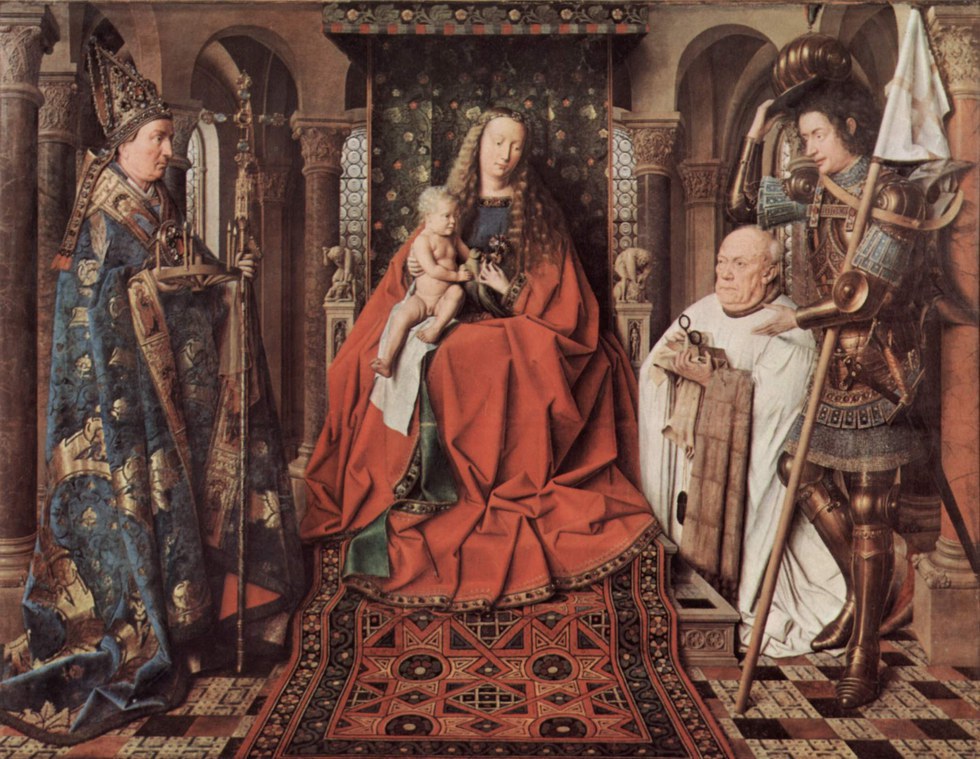
In the Groeningemuseum, they stood in front of Van Eyck’s Virgin and Child with Canon van der Paele. Then something remarkable happened. Dieter began to talk to his father.
He began an impromptu dissertation on the painting. He left the more common information about it behind, and went directly to subtleties and an exploration of the more obscure aspects of it. He began to identify and unravel the complex layers of symbolism the painter had embedded in the work. Dieter’s father noted that not only were his son’s observations entirely accurate, but the boy went further and added insights that seemed to be completely his own, and these insights were perceptive, and highly original.
For a moment, Dieter’s father was pleased. This was obviously Dieters’s “audition”’ for the job of running his father’s business. And he had done well; quite well, indeed.
But Dieter hadn’t finished. He had more to say about the Virgin and Child.
He took his analysis deeper and expanded on it. His discourse drew on a stunning understanding of Dutch and Flemish art. He compared, he explained, he made surprising connections.
His father’s satisfaction was short-lived. Showing off a little was fine, but wasn’t this a bit too much? Wasn’t it rather presumptuousof the boy to lecture his father, who, after all, had written an entire book on the Virgin and Child?
Then it occurred to him: was he listening to his son? Or was he listening to the machine – that tiny, expensive device he’d had installed in his son’s head? Was it just a piece of hardware that was lecturing him?
Dieter continued to talk, showing no sign of exhausting his knowledge of the painting. His father was getting irritated. The backbrain was a clever thing, he thought. but it was still a parlor trick,and he was not going to be talked down to by such a thing.
The last straw was when Dieter referenced his book on the painting—quoting it verbatim — and then had the gall to correct what he had said!
Naturally, he had to defend what he had written, and he did so. Dieter listened to his father’s defense without interrupting. But when the older man stopped talking, Dieter calmly dismantled that defense, piece by piece. He took up his original point again, but now made it into more of a discussion than a lecture. He gave his father room to speak and to question Dieter’s own assertions. He drew his father out, and asked him follow-up questions, and put his father’s own expertise to the test. The older man became increasingly irritated as Dieter found, again and again, ways to correct and contradict him. No less than twice, he made a fool of him. Dieter was giving his father a sound intellectual thrashing, and he seemed to be doing it effortlessly.
The worst part was that the small, momentary comfort he had taken in thinking it was just the machine talking had slipped away from him.
The academic drubbing he was receiving had a cruelty to it, a vengeance, that could only come from a human source.
He saw clearly now the real point of the visit to the Groeningemuseum. Dieter had brought him there to shame him; destroy him.
They said goodbye in front of Gerard David’s The Judgment of Cambyses. Dieter’s father stared at the painting, dazed, as his son walked away.
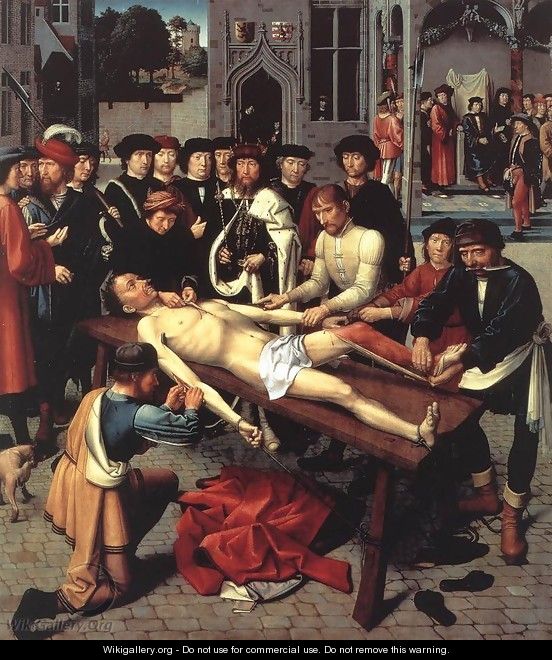
The Judgment of Cambyses was a depiction of the corrupt Persian judge, Sisamnes, being flayed alive by the townspeople. They had Sisamnes stretched out and tied to a table. With sharp knives they were opening him up – at the sternum, the side of the arm, and the leg. Dieter’s father studied the scarlet tissue of the leg muscles, laid bare by the man at Sisamnes’ foot, as he peeled the judge’s skin away from knee to ankle.
He knew exactly how Sisamnes felt.
Dieter left the museum in high spirits. He felt free; he felt the presence of the wide world in front of him. Life seemed exciting and receptive to anything.
But the years that followed, which seemed so promising to Dieter at that moment, would be short in number and miserable in spirit.
The backbrain insertion began to kill him, just as it had done to the unfortunate others who had undergone the procedure. The symptoms started later in Dieter than with the others. But once the process started, it was quick and irreversible. His nervous system was collapsing.
His motor skills deteriorated, and he was caught and arrested one morning at the train station. His father bailed him out and kept the incident quiet, but it was solely to protect his own good name. He’d already given up on Dieter. He saw how hard it was for Dieter to move his fingers now. And he’d learned how badly the backbrain insertions had gone for the others. Dieter was going to fare no better.
A month later, Dieter was arrested again. Dieter’s father did not save him. He died in a prison cell, in his beautiful, exciting city of Brussels.
Full body scanning and hardware retrieval was a standard part of mortuary services. Prosthetic limbs, artificial eyes, hearing implants, and steel bones were removed and put into storage or sold for future use. The backbrain was spotted and pulled out of Dieter before he was cremated.
The small flat piece of hardware was removed and reported to the authorities. It was catalogued and filed away by the State.
The world inside the backbrain ended as soon as Dieter’s frontbrain shut down. It disappeared as suddenly as it had begun.